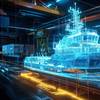New Shipboard Insulation Expected to Save Time and Money
From Naval Sea Systems Command Public Affairs
Systems Command's (NAVSEA's) Engineering for Reduced Maintenance (ERM) team outlined Sept. 29 a new thermal barrier materials initiative designed to reduce maintenance expenses, improve shipboard quality of life and reduce shipboard weight.
ERM is part of NAVSEA's Naval Systems Engineering Directorate team which seeks to streamline costly and time-consuming maintenance procedures in the fleet.
Thermal barriers, the insulation on high temperature pipes and equipment, protect Sailors from serious burns and keep heat from dissipating, improving operational efficiency. Current insulation, commonly called "lagging," consists of up to six inches of a heavy, mortar-like, calcium silicate compound encased in fiberglass cloth. The brittle material damages easily, especially in high traffic spaces, and creates dust and other debris as it deteriorates. Replacing the insulation is messy and labor-intensive.
One of the new materials, said Vernon Parrish, Program Coordinator for NAVSEA's Engineering for Reduced Maintenance (ERM) Program, is high temperature densified polyimides, pre-formed rigid foam installed in a two-piece, "clam shell" sections and encased in fiberglass cloth.
The new insulation was tested, installed and evaluated by the , Carderock Division Ship Systems Engineering Station, a NAVSEA field activity.
Citing data gathered after the June installation of high temperature polyimides on the guided missile destroyer USS Mahan (DDG-72), Parrish projected annual maintenance savings of $5,000 per ship over 10 years. Installing the new materials throughout the fleet could save $1.3 million over 10 years.
The thermal barrier initiative is one of several programs overseen by ERM. The program explores ways to reduce shipboard material and equipment breakdowns by introducing commercially available products and technologies to the fleet or by re-engineering existing components for greater durability and efficiency.












